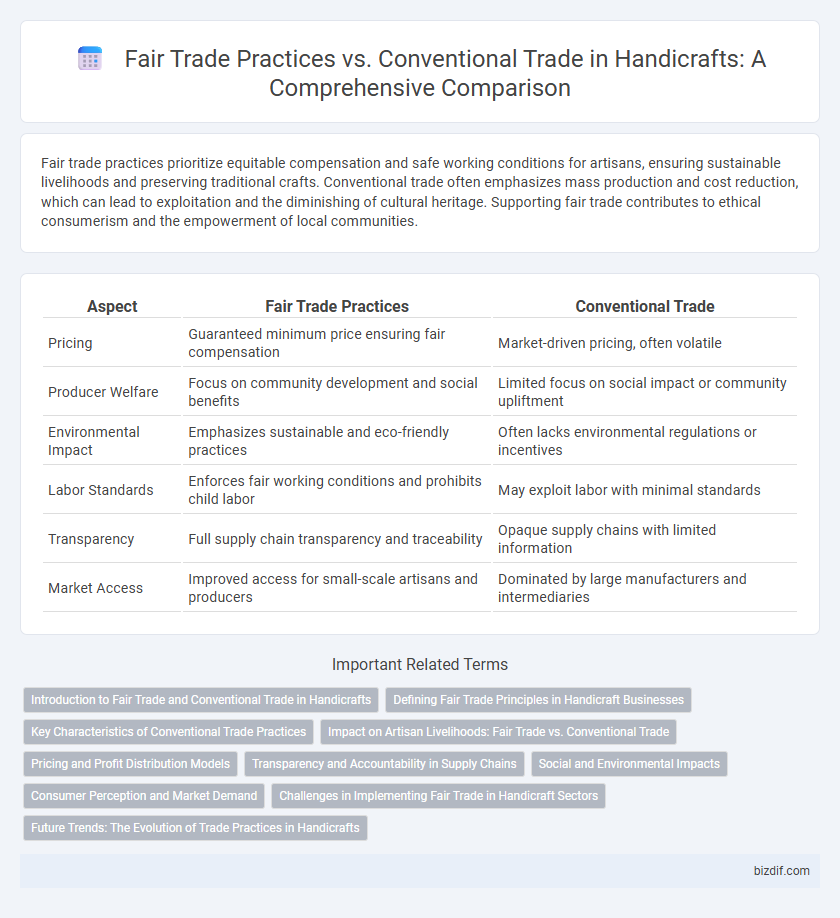Fair trade practices prioritize equitable compensation and safe working conditions for artisans, ensuring sustainable livelihoods and preserving traditional crafts. Conventional trade often emphasizes mass production and cost reduction, which can lead to exploitation and the diminishing of cultural heritage. Supporting fair trade contributes to ethical consumerism and the empowerment of local communities.
Table of Comparison
| Aspect | Fair Trade Practices | Conventional Trade |
|---|---|---|
| Pricing | Guaranteed minimum price ensuring fair compensation | Market-driven pricing, often volatile |
| Producer Welfare | Focus on community development and social benefits | Limited focus on social impact or community upliftment |
| Environmental Impact | Emphasizes sustainable and eco-friendly practices | Often lacks environmental regulations or incentives |
| Labor Standards | Enforces fair working conditions and prohibits child labor | May exploit labor with minimal standards |
| Transparency | Full supply chain transparency and traceability | Opaque supply chains with limited information |
| Market Access | Improved access for small-scale artisans and producers | Dominated by large manufacturers and intermediaries |
Introduction to Fair Trade and Conventional Trade in Handicrafts
Fair trade in handicrafts emphasizes ethical sourcing, ensuring artisans receive fair wages and work in safe conditions, contrasting with conventional trade that often prioritizes profit over social impact. Fair trade organizations promote transparency, sustainability, and community development, directly benefiting local craftsmen and preserving traditional skills. Conventional trade channels may lack these ethical standards, frequently involving intermediaries that reduce artisan earnings and inhibit equitable growth.
Defining Fair Trade Principles in Handicraft Businesses
Fair trade principles in handicraft businesses emphasize ethical sourcing, equitable wages, and empowering artisan communities by ensuring transparency across the supply chain and fostering sustainable development. Unlike conventional trade, fair trade prioritizes social justice, environmental stewardship, and long-term partnerships that support artisans' cultural heritage and economic resilience. Certification bodies like Fair Trade International and WFTO provide standards that guide fair business practices, promoting fair pricing, safe working conditions, and capacity-building initiatives.
Key Characteristics of Conventional Trade Practices
Conventional trade practices in handicrafts often emphasize mass production and cost efficiency, leading to larger-scale operations with less emphasis on artisan welfare. These practices typically involve multiple intermediaries that reduce direct benefits to individual craftsmen, resulting in lower profit margins for producers. Quality control may prioritize uniformity over uniqueness, and environmental or social standards are often secondary to market demands and profitability.
Impact on Artisan Livelihoods: Fair Trade vs. Conventional Trade
Fair trade practices ensure artisans receive equitable wages by promoting transparency and direct purchasing, significantly improving their economic stability and quality of life. Conventional trade often involves intermediaries that reduce profit margins for artisans, leading to lower income and limited community development. Empowering artisan livelihoods through fair trade fosters sustainable growth, preserves cultural heritage, and promotes ethical consumerism.
Pricing and Profit Distribution Models
Fair trade practices in handicrafts ensure artisans receive equitable pricing that reflects the true value of their skilled labor, promoting sustainable livelihoods. Profit distribution models under fair trade prioritize community reinvestment and transparent transactions, contrasting with conventional trade's focus on maximizing profits for intermediaries and retailers. This ethical pricing structure supports economic empowerment and preserves traditional craftsmanship.
Transparency and Accountability in Supply Chains
Fair trade practices in handicrafts emphasize transparency and accountability by ensuring all stakeholders--from artisans to consumers--are informed about production processes and ethical sourcing. These practices mandate clear documentation and traceability within supply chains, contrasting conventional trade's often opaque operations. Enhanced transparency in fair trade supports equitable payments, better working conditions, and sustainable development for craft communities.
Social and Environmental Impacts
Fair trade practices in handicraft prioritize equitable wages and safe working conditions, promoting social empowerment and community development, while conventional trade often neglects these aspects, leading to exploitation and poor labor standards. Environmentally, fair trade emphasizes sustainable sourcing and eco-friendly production methods, reducing deforestation, pollution, and resource depletion, whereas conventional trade typically prioritizes cost reduction with less regard for environmental harm. The integration of fair trade principles fosters long-term social welfare and ecological balance, contrasting sharply with the short-term profit focus of conventional supply chains.
Consumer Perception and Market Demand
Fair trade practices in handicrafts emphasize ethical sourcing, equitable wages, and sustainable production, which significantly enhance consumer perception by aligning with growing demand for socially responsible products. Consumers increasingly favor fair trade handicrafts due to transparency and positive social impact, leading to heightened market demand compared to conventional trade items often associated with mass production and lower labor standards. This shift drives premium pricing and stronger brand loyalty within niche markets focused on ethical consumption.
Challenges in Implementing Fair Trade in Handicraft Sectors
Implementing fair trade in the handicraft sector faces significant challenges such as ensuring transparent supply chains and verifying the authenticity of artisan-made products. Limited access to fair trade certification and the dominance of conventional trade networks often result in unfair pricing and exploitation of artisans. Additionally, logistical complexities and market awareness gaps hinder the scalability of fair trade initiatives within the global handicraft market.
Future Trends: The Evolution of Trade Practices in Handicrafts
Fair trade practices in handicrafts emphasize ethical sourcing, equitable wages, and environmental sustainability, setting a strong foundation for future market growth. Conventional trade often prioritizes cost efficiency and mass production, but evolving consumer awareness is shifting demand toward transparent and socially responsible supply chains. Emerging trends indicate increased integration of blockchain for supply chain verification and digital platforms that connect artisans directly with global consumers, reshaping trade practices for more inclusive and sustainable growth.
Fair trade practices vs Conventional trade Infographic

 bizdif.com
bizdif.com